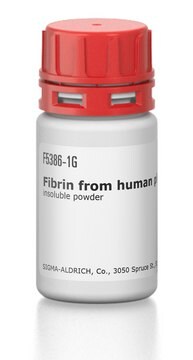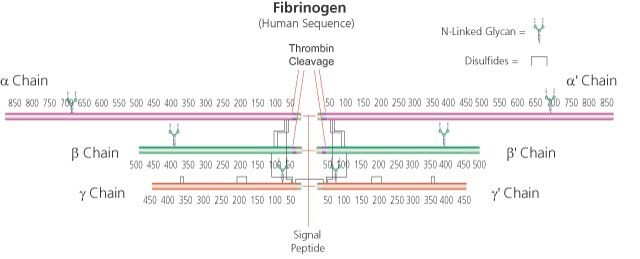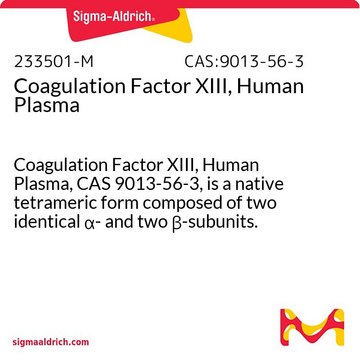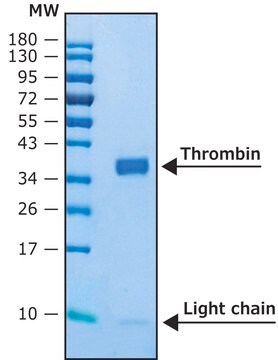F4883
Fibrinogen from human plasma
35-65% protein (≥90% of protein is clottable).
Sinónimos:
Factor I
About This Item
Productos recomendados
origen biológico
human plasma
Nivel de calidad
descripción
essentially plasmin(ogen) free
formulario
powder
calidad
35-65% protein (≥90% of protein is clottable).
mol peso
α-chain 63.5 kDa
β-chain 56 kDa
γ chain 47 kDa (about 4% carbohydrate content)
soluble dimer 340 kDa
concentración
35-65% protein (biuret)
técnicas
cell culture | mammalian: suitable
solubilidad
0.9% NaCl: soluble
temp. de almacenamiento
−20°C
¿Está buscando productos similares? Visita Guía de comparación de productos
Descripción general
Aplicación
- fibrinogen adsorption assay performed on swCNTs (single-walled carbon nanotubes)
- the characterization of fibrinogen structure in the presence of CNT using CD (Circular dichroism) spectroscopy and temperature scan
- the preparation of RBC suspension obtained from venous blood of antecubital vein, to assess RBC aggregability
- fibrinolysis assay performed on mouse embryonic fibroblasts (MEFs)
- the preparation of fibrinogen-labeled gold (Fgn/Au)
- the quantification of in vitro angiogenesis by human microvascular endothelial cells and
- the assessment of fibrin-induced apoptosis and differentiation-regulation in trophoblast obtained from term human placentas.
Acciones bioquímicas o fisiológicas
Especificaciones
Forma física
Nota de análisis
Cláusula de descargo de responsabilidad
Código de clase de almacenamiento
11 - Combustible Solids
Clase de riesgo para el agua (WGK)
WGK 3
Punto de inflamabilidad (°F)
Not applicable
Punto de inflamabilidad (°C)
Not applicable
Equipo de protección personal
Eyeshields, Gloves, type N95 (US)
Certificados de análisis (COA)
Busque Certificados de análisis (COA) introduciendo el número de lote del producto. Los números de lote se encuentran en la etiqueta del producto después de las palabras «Lot» o «Batch»
¿Ya tiene este producto?
Encuentre la documentación para los productos que ha comprado recientemente en la Biblioteca de documentos.
Los clientes también vieron
Nuestro equipo de científicos tiene experiencia en todas las áreas de investigación: Ciencias de la vida, Ciencia de los materiales, Síntesis química, Cromatografía, Analítica y muchas otras.
Póngase en contacto con el Servicio técnico









